#100 years of climate change science
Explore tagged Tumblr posts
Text
Article: The lost history of what Americans knew about climate change in the 1960s
The lost history of what Americans knew about climate change in the 1960s
Just like the Supreme Court lied that "There were no gun regulations when the Constitution was written." (There were many, not that it should mattter. AR-15s did not exist in the 1700s.)
Now they lie, "No one anticipated climate change, so now Congress can't let the EPA regulate it." Again, baloney. (To be polite.) See article above.
The "Major Questions" doctrine, which never existed until we had six right right-wing partisans as judges, really just means the: "What Might Lessen Corporate Profits" doctrine. That is obvious since their judicial reasoning fails to ever account for any impact on actual US citizens of industrial behavior.
The Supreme Court is essentially saying "Congress doesn't have the authority to pass and enforce laws in good faith to protect American citizens."
The hell it doesn't. At least Congress is ELECTED, giving them the authority of the public. The justices are merely APPOINTED. They are the LEAST representative branch of government.
The scientists on the EPA and other bodies are EXPERTS. Supreme Court member are obviously not. Recent Supreme Court decisions have been riddled with errors on basic science. EXPERTISE gives EPA regulators moral authority.
It is simply common sense that the public has a vested interest in breathing clean air and drinking clean water as well as avoiding catastrophic climate change.
Supreme Court decisions now consistently and arbitrarily fall on the side commonly associated with right-wing politics: profit & religion.
The only thing that gave unelected Supreme Court justices moral authority, since they are not elected, was being fair, following precedent, and ruling as narrowly as possible to have minimal impact on laws already passed by ELECTED officials.
The Supreme Court has annointed themselves the "The High Tribunal of all that is Unconstitutional for Every Law Inconvenient to Profit or Religious Zealotry."
#corrupt supreme court#scientists have warned about climate change for 100 years#100 years of climate change science
1 note
·
View note
Text
Here's the top 2 stories from each of Fix The News's six categories:

1. A game-changing HIV drug was the biggest story of 2024
In what Science called the 'breakthrough of the year', researchers revealed in June that a twice-yearly drug called lenacapavir reduced HIV infections in a trial in Africa to zero—an astonishing 100% efficacy, and the closest thing to a vaccine in four decades of research. Things moved quick; by October, the maker of the drug, Gilead, had agreed to produce an affordable version for 120 resource-limited countries, and by December trials were underway for a version that could prevent infection with just a single shot per year. 'I got cold shivers. After all our years of sadness, particularly over vaccines, this truly is surreal.'
2. Another incredible year for disease elimination
Jordan became the first country to eliminate leprosy, Chad eliminated sleeping sickness, Guinea eliminated maternal and neonatal tetanus, Belize, Jamaica, and Saint Vincent & the Grenadines eliminated mother-to-child transmission of HIV and syphilis, India achieved the WHO target for eliminating black fever, India, Viet Nam and Pakistan eliminated trachoma, the world’s leading infectious cause of blindness, and Brazil and Timor Leste eliminated elephantiasis.
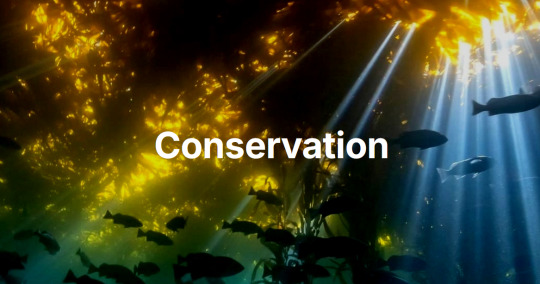
15. The EU passed a landmark nature restoration law
When countries pass environmental legislation, it’s big news; when an entire continent mandates the protection of nature, it signals a profound shift. Under the new law, which passed on a knife-edge vote in June 2024, all 27 member states are legally required to restore at least 20% of land and sea by 2030, and degraded ecosystems by 2050. This is one of the world’s most ambitious pieces of legislation and it didn’t come easy; but the payoff will be huge - from tackling biodiversity loss and climate change to enhancing food security.
16. Deforestation in the Amazon halved in two years
Brazil’s space agency, INPE, confirmed a second consecutive year of declining deforestation in the Brazilian Amazon. That means deforestation rates have roughly halved under Lula, and are now approaching all time lows. In Colombia, deforestation dropped by 36%, hitting a 23-year low. Bolivia created four new protected areas, a huge new new state park was created in Pará to protect some of the oldest and tallest tree species in the tropical Americas and a new study revealed that more of the Amazon is protected than we originally thought, with 62.4% of the rainforest now under some form of conservation management.
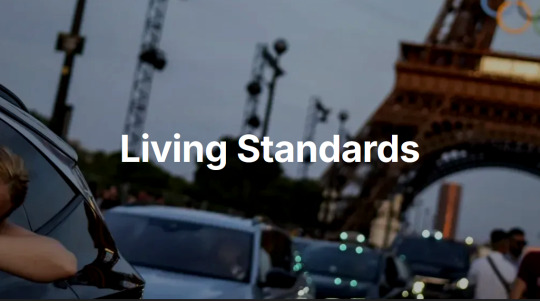
39. Millions more children got an education
Staggering statistics incoming: between 2000 and 2023, the number of children and adolescents not attending school fell by nearly 40%, and Eastern and Southern Africa, achieved gender parity in primary education, with 25 million more girls are enrolled in primary school today than in the early 2000s. Since 2015, an additional 110 million children have entered school worldwide, and 40 million more young people are completing secondary school.
40. We fed around a quarter of the world's kids at school
Around 480 million students are now getting fed at school, up from 319 million before the pandemic, and 104 countries have joined a global coalition to promote school meals, School feeding policies are now in place in 48 countries in Africa, and this year Nigeria announced plans to expand school meals to 20 million children by 2025, Kenya committed to expanding its program from two million to ten million children by the end of the decade, and Indonesia pledged to provide lunches to all 78 million of its students, in what will be the world's largest free school meals program.
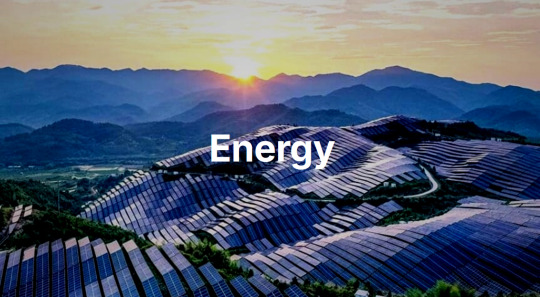
50. Solar installations shattered all records
Global solar installations look set to reach an unprecedented 660GW in 2024, up 50% from 2023's previous record. The pace of deployment has become almost unfathomable - in 2010, it took a month to install a gigawatt, by 2016, a week, and in 2024, just 12 hours. Solar has become not just the cheapest form of new electricity in history, but the fastest-growing energy technology ever deployed, and the International Energy Agency said that the pace of deployment is now ahead of the trajectory required for net zero by 2050.
51. Battery storage transformed the economics of renewables
Global battery storage capacity surged 76% in 2024, making investments in solar and wind energy much more attractive, and vice-versa. As with solar, the pace of change stunned even the most cynical observers. Price wars between the big Chinese manufacturers pushed battery costs to record lows, and global battery manufacturing capacity increased by 42%, setting the stage for future growth in both grid storage and electric vehicles - crucial for the clean flexibility required by a renewables-dominated electricity system. The world's first large-scale grid battery installation only went online seven years ago; by next year, global battery storage capacity will exceed that of pumped hydro.
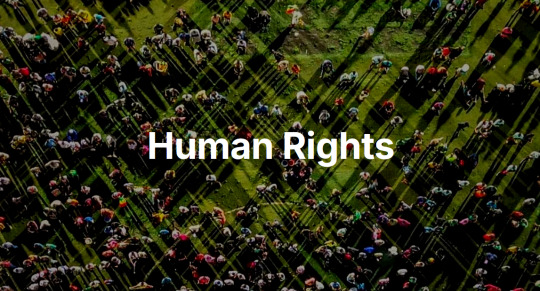
65. Democracy proved remarkably resilient in a record year of elections
More than two billion people went to the polls this year, and democracy fared far better than most people expected, with solid voter turnout, limited election manipulation, and evidence of incumbent governments being tamed. It wasn't all good news, but Indonesia saw the world's biggest one day election, Indian voters rejected authoritarianism, South Korea's democratic institutions did the same, Bangladesh promised free and fair elections following a 'people's victory', Senegal, Sri Lanka and Botswana saw peaceful transfers of power to new leaders after decades of single party rule, and Syria saw the end of one of the world's most horrific authoritarian regimes.
66. Global leaders committed to ending violence against children
In early November, while the eyes of the world were on the US election, an event took place that may prove to be a far more consequential for humanity. Five countries pledged to end corporal punishment in all settings, two more pledged to end it in schools, and another 12, including Bangladesh and Nigeria, accepted recommendations earlier in the year to end corporal punishment of children in all settings. In total, in 2024 more than 100 countries made some kind of commitment to ending violence against children. Together, these countries are home to hundreds of millions of children, with the WHO calling the move a 'fundamental shift.'
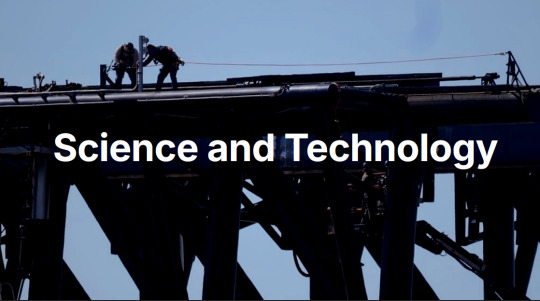
73. Space exploration hit new milestones
NASA’s Europa Clipper began a 2.9 billion kilometre voyage to Jupiter to investigate a moon that may have conditions for life; astronomers identified an ice world with a possible atmosphere in the habitable zone; and the James Webb Telescope found the farthest known galaxy. Closer to Earth, China landed on the far side of the moon, the Polaris Dawn crew made a historic trip to orbit, and Starship moved closer to operational use – and maybe one day, to travel to Mars.
74. Next-generation materials advanced
A mind-boggling year for material science. Artificial intelligence helped identify a solid-state electrolyte that could slash lithium use in batteries by 70%, and an Apple supplier announced a battery material that can deliver around 100 times better energy density. Researchers created an insulating synthetic sapphire material 1.25 nanometers thick, plus the world’s thinnest lens, just three atoms across. The world’s first functioning graphene-based semiconductor was unveiled (the long-awaited ‘wonder material’ may finally be coming of age!) and a team at Berkeley invented a fluffy yellow powder that could be a game changer for removing carbon from the atmosphere.
-via Fix The News, December 19, 2024
#renumbered this to reflect the article numbering#and highlight just how many stories of hope there are#and how many successes each labeled story contains#2024#good news#hope#hope posting#hopeposting#hopepunk#conservation#sustainability#public health#energy#quality of life#human rights#science and technology
3K notes
·
View notes
Text
When I was 10 (aka 2009): Summer heatwave peak was 24°C in June / July. Late August & early September meant rainstorms, hailstones, 60mph winds, leaves starting to change colour & needing to wear a jacket for the first time since May. Late September meant conkers & helicopters & piles upon piles of leaves to kick around & play with & getting bugs in your hair. October meant frosty mornings, and crunchy leaves, and wearing a scarf to school & watching frost form on the roads in the evening & it meant getting a heatpack out for the first time since March. November meant hats, gloves / mittens, scarf, thick jumper, big jacket & a change of boots because the boots we all wore to get to school were not the boots we wore in school & so we had to be able to change them, & it meant putting the heating on again & it meant winter prayers on the balcony & it meant the smell of decomposing leaves in the forest & it meant seeing your breath fog up in front of you with every syllable & stay there as a solid cloud for a few moments. December meant feet of snow on every street, & sheets upon sheets of solid ice & it meant solstice prayers and chants & it meant fog so thick you couldn't see your hand if you held it up in front of your face & it meant robins hopping along hedges & it meant taking a hot water bottle to bed every night & it meant onesies were worn under blankets & it meant snow so heavy and constant that schools shut down because there was a danger of us getting genuinely snowed in if we stayed until the end of the day.
When I was 16 (aka 2015): Summer heatwave peak was 30°C in July. Late August meant heavy acid rain & gale force winds. Early September meant heatwaves up to 18°C & daylightning storms. Late September meant shoes got swapped for ankle boots. October meant light layers & a denim jacket. November meant fireworks were canceled because of heavy downpours. December meant floods so severe people were evacuated & others had row boats to get along the streets & schools shutting down because no one could get in without risking drowning or getting separated from their family.
Now that I'm 24 (2023): Summer heatwave average was 35°C in May & 40°C in June. Late August meant draughts & forest fires at the same time as severe flash floods. September means acid rain & average temperatures of 22°C. October will mean rain & wearing a jacket again for the first time since April. November will mean forest fires & flash floods. December will mean sunny days without any snow or ice after 11am.
I live in Scotland.
||| if you have the time & wanna see how we impact climate change & the difference between human-fueled climate change versus natural earth cycles of fluctuating climates type of climate change, check out Chris Packham's Earth series. He's amazing, it's amazing, and he addresses some really relevant things while also explaining how the climate crisis is completely different to the natural climate cycles which formed our planet & the impact each climate change has on our planet |||
Climate denialism in the netherlands is so fucking funny like. Bro the floods. They’re coming
#climate deniers here: WE LIVE ON AN ISLAND OF COURSE WE'RE GOING TO HAVE FLUCTUATING UNPREDICTABLE WEATHER#science & climate change: actually its 100% predictable based on this graph of history and IT IS NOT GOOD#yes the climate will always change#but we do not have to be the thing that keeps fueling it#how can you say climate change isnt real & that the climate crisis isnt real when the weather we had 10 years ago is nonexistent now???
53K notes
·
View notes
Text
HEYA WHO WANTS TO LEARN ABOUT GRASS AND VOLCANOES
Yes I'm alive and yes I'm making posts and music again. Ok so moving on HAVE YOU SEEN THIS GRASS???
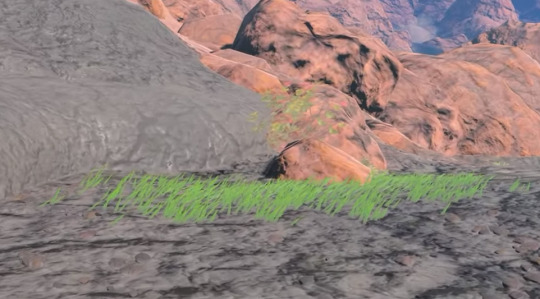
This patch of grass is from a Youtube video by Quincyvhs ranking grass in Tears of the Kingdom. He's a cool guy and has a similar video on Breath of the Wild and I highly recommend you watch it cause his editing is very cool.
HOWEVER. He made an egregious error today by ranking this patch of grass, this lovely, magnificent, extraordinary patch of grass upon Death Mountain as a mere B Tier. It clearly is an S Tier.
How do I know this? Well this patch of grass indicates miracles. It indicates determination. It indicates the spirit of adventure, of change, of liberty and mayhaps even the purest form of happiness the world round...
...and as later corroborated by the actual geologist that I am dating, it is an indication of the massive shift in Hyrule's ecosystem and climate.
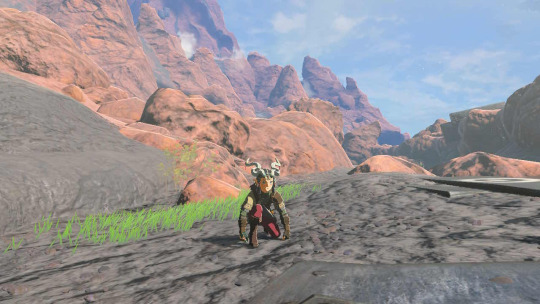
Let's Begin.
Using my ace detective skills I have located the site in question in both Breath of the Wild and Tears of the Kingdom (Botw and Totk). The general consensus is that there is a 5~ year time gap between the two games.
Given that the grass does not exist here in Botw, this means that this patch of grass took at maximum 5 years to grow. However, I'm going to prove that it probably took even less time than even that.
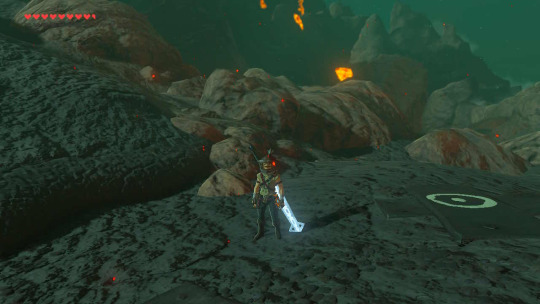
Below is the site on Botw's Map:
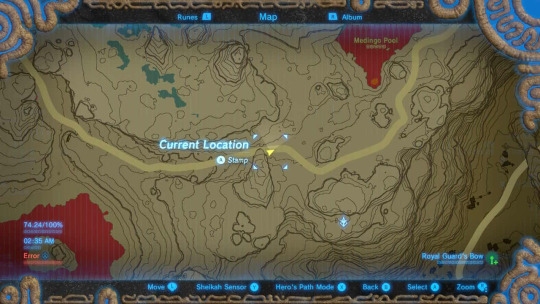
We are unable to get an accurate temperature reading of the area because the Sheikah Slate decided to give up. So we're going to use science to determine this soon to be important number
Given that wood near instantly ignites at this location in Botw, we can conclude that the temperature in the air is around 370 degrees Celcius or 700 degrees Fahrenheit.
Now typically, rock and soil serve as good insulators of heat, so the air temperature around a volcano itself isnot usually that much higher than the ambient temperature (unless you are actively within a Pyroclastic flow, which would be a more pressing problem than analyzing grass to say the least)
However, when near the presence of lava, that temperature of the air can actually reach up to 1000 degrees Celcius (1800F) so this reading is actually even more reasonable when you note that we are in good distance of the Medingo Lava Pool.
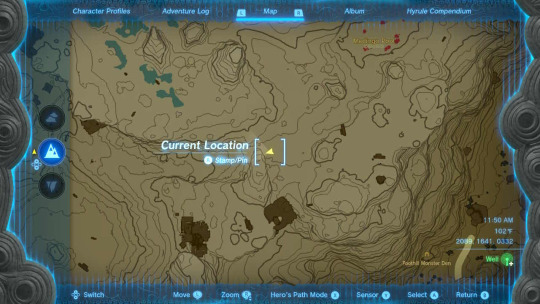
Conversely, we can actually grab an active temperature reading of the area during the time of Totk thanks to the Purah Pad.
It's 102 degrees Fahrenheit.
Easy. Simple. Fantastic. I love when my job doesn't require four hours of research for every single question!
Anyhow, here are some figures from the Oregon State Volcanology Laboratory on the rate of lava cooling


Yes this post is still about grass, stay with me.
To truly appreciate the glory of science and the glory of this patch of grass, we are going to calculate the exact amount of time needed for the temperatures to lower on Death Mountain to one sustanable for growth (That being around 100 degrees Farenheit).
SPOILER ALERT: It takes less than 5 years. This is insanely impressive considering grass of this type* typically takes DECADES.
Anyhow, The Figure 2 and 3 have to do with the depth of the lava, and Figure 4 deals with the thickness. (Many thanks again to my partner for providing their geological expertise and resources)
The thickness of the Medingo Lava is very easy to calculate given that Link can literally jump in with a splash and drown in it like the world's worst hot tub--the bitch ain't thick at all. So we use the lowest listed reading for that.
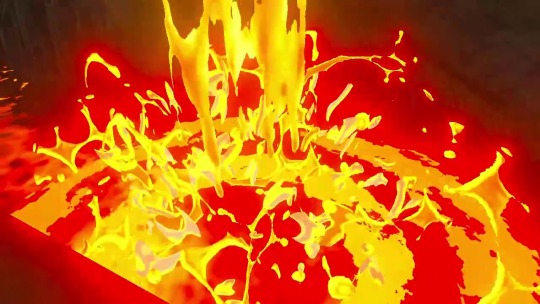
The depth of the lava is more tricky, but comparing the lava pool in Botw and Totk, and using Link as a marker of around 5 feet, we can say that the pool is around 10 feet deep.
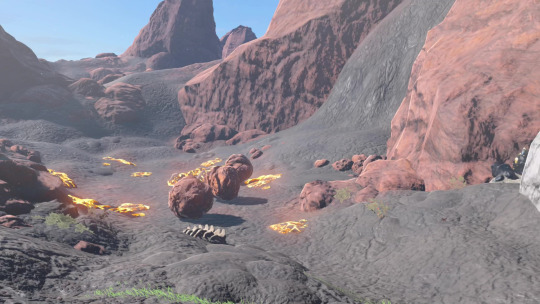
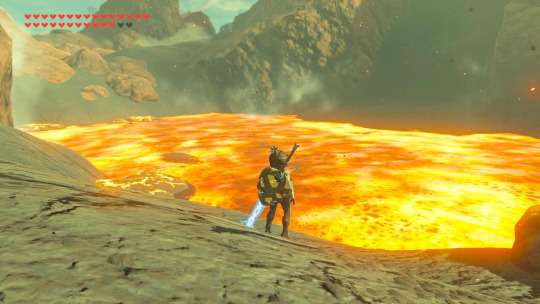
Therefore, the Medingo Lava Pool took around 2-3 years to cool after Death Mountain stopped erupting.
Now when exactly did Death Mountain stop erupting?
According to the catalog of Volcanoes of the World by the Smithsonian Institution, 93% of volcanos stop erupting within 3 years.
Now I know that Death Mountain only started erupting because of the return of the Divine Beast Vah Rudania, and Link only "stops" the eruption of Death Mountain by defeating it. So one could argue that Death Mountain's "eruption" had to be less than a year or something.
My rebuttal to that would be 1) Within the game's canon, I don't see how we could justify Link taking one day, or even one month to wake up from the Great Plateau, travel immeidately all the way to Death Mountain. and then tame the Divine Beast in less than a month, and 2) Link didn't really stop shit because we can clearly still see active lava flow after taming Rudania. He only stopped the rock falls caused by the Divine Beast, the actual activity of Death Mountain still continues.
Given its insane size, I am going to say it took the full 3 years for its active lava flow to stop on Death Mountain. Volconologists in the notes, feel free to correct me.
SO! The Timeline is:
3 years for Death Mountain to stop actively flowing
2 years minimum for Medingo Lava Pool to cool
= >1 year for temperatures to be right for grass to grow!
This is an insanely quick time period for grass to thrive! The literal instant that the conditions were correct, we are able to see not just grass, but stoloniferous grass as well other types of shrubbery thrive! We would usually need several years for the volcanic rock to erode to rich soil (such as the soil in the Akkala region)
Allow me to elaborate:
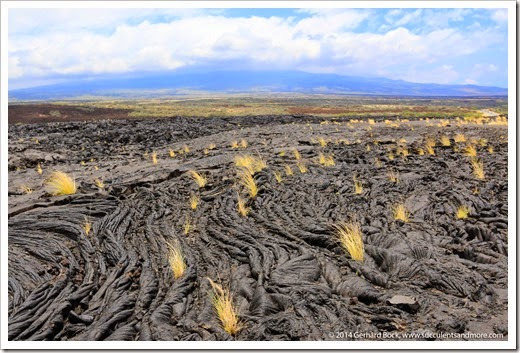
This is Fountain Grass. Fountain grass is usually the fist type of grass that you would see in a volcanic region. They grow from a rhizome root system, which is a very vertical downward root system as you can see. This is good for young volcanic regions where only specific dotted areas are good enough for plants to grip onto and grow.
They grow something like this:

This patch of grass below I would call some sort of rhizome. (Botanists feel free to correct me in the notes)
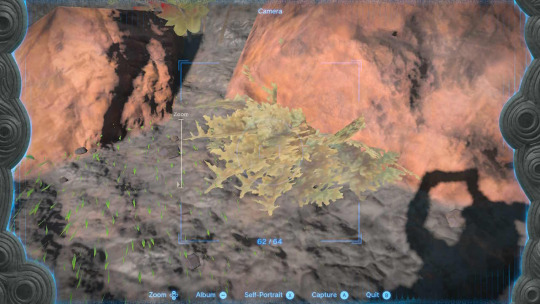
THIS. however. (amazingly) is an example of stoloniferous grass!
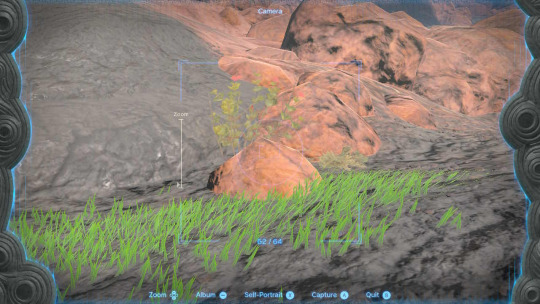
This is thick bladed grass (as opposed to the more thin, fine-bladed grass with rhizomes) that grow in a stolon spreading pattern that is much more horizontal. It's a lot like the grass that might grow in your front lawn, if you're rich enough to have one of those in this economy--
They grow a bit more like this:
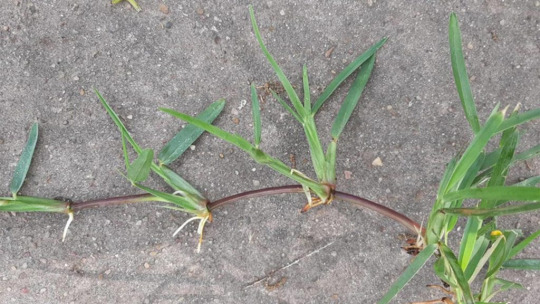
This type of grass need soil! Especially if we want to classify that other red flower behind the rock there as some sort of volcanic flower

We're basically talking about mass, rapid volcanic erosion in less than a year for this to happen. For context, the soil necessary for the region of Akkala to grow could have taken anywhere between a decade to thousands of years. The weather and erosion necessary for this patch of grass to grow took, at most, 3 years.
And all this in the period of time following an actual apocalypse. How quickly the tides have turned for Hyrule's ecosystem!!!!
IT'S A VERY IMPRESSIVE AND COOL PATCH OF GRASS AND THUS IS DESERVING OF THE S TIER RANKING
Also here's some behind the scenes of what my much smarter than me partner had to say about it ["Last pictures referencing the rhizome grass which, indeed, would be the oldest grass among the patch given it needs the least specific conditions to thrive/less soil to get started]
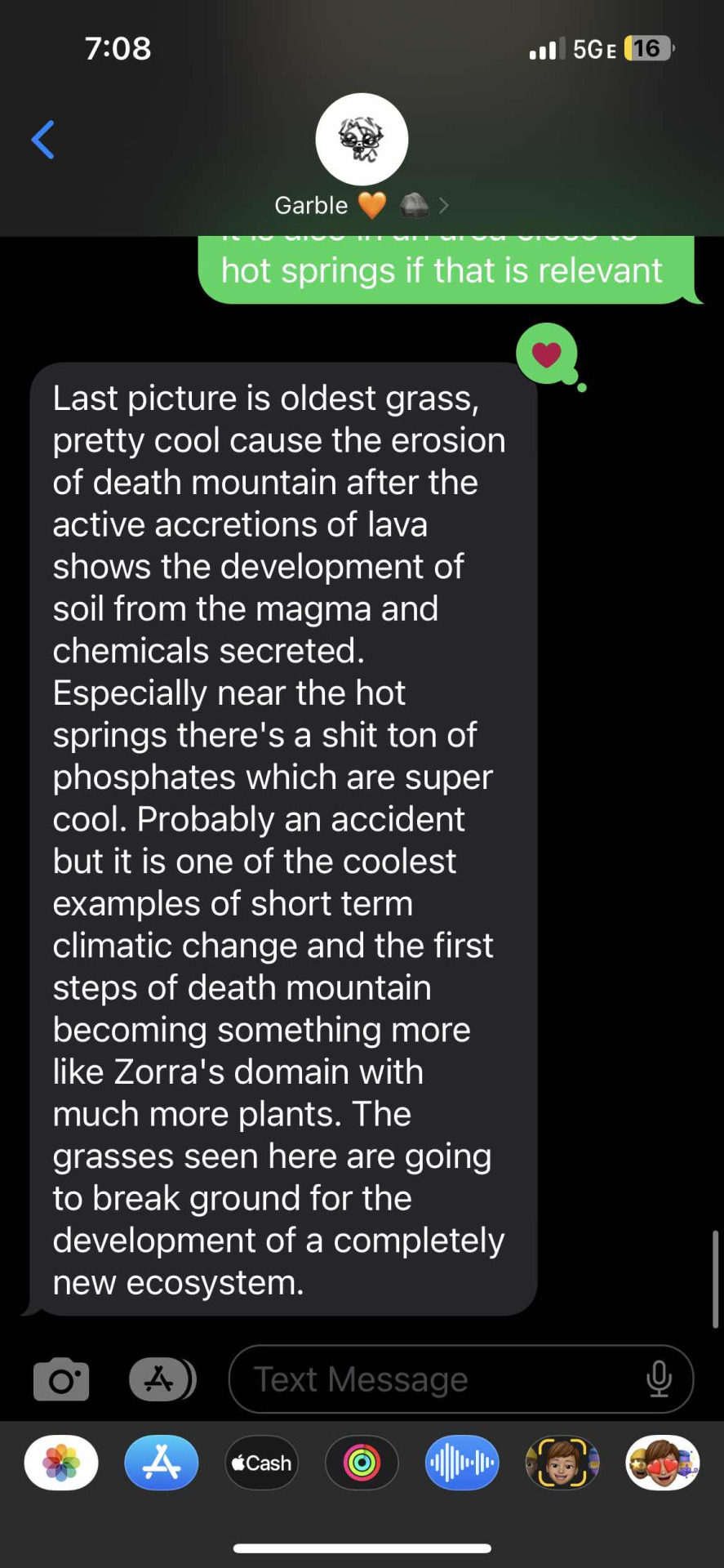
Growth is cool.
#tears of the kingdom#breath of the wild#botw#totk#OK MY PARTNER ACTUALLY DOING SCIENCE IN THE MIDDLE OF THE WOODS AND THEY CANT CONFIRM THE ACTUAL TIMELINE WITHOUT#HAVING ACCESS TO THE INTERNET BUT i think my research is sound enough for tumblr
379 notes
·
View notes
Text
Science, and The Lie of Certainty
When you were a child, you probably learned in school what a dinosaur was. You probably learned about their habitats. You probably have seen their pictures in your textbooks.
Not to mention seeing them in movies like Jurassic Park, The Land Before Time, The Good Dinosaur, etc.
Except thinking about what dinosaurs look like, you probably realize that they have changed. Our understanding of what they most likely look like has changed. And in the media that we consume, the dinosaurs look differently today than they did 30 years ago.
Even in media, the dinosaurs depicted in The Good Dinosaur look different from what we saw in Jurassic Park.
As children, you were probably certain about what dinosaurs look like. They're in books, after all!
Maybe you still feel a certainty today. Maybe you think that the new more hairy and feathery dinosaurs that we would see in modern images are what they actually look like and this is going to stay the same and never change.
So allow me to inform you that, unfortunately, your certainty is misplaced.
The truth is, even as much as we know about dinosaurs today, we will probably never know exactly what they looked like. There are some things that just don't fossilize and won't be preserved.
We can guess at their habitats, at their behavior, and scientists can get a whole lot right.
But we will probably never have textbooks that will 100% portray what a dinosaur looked like.
And this is pretty sad to me. Because I like to know the answers to questions. I want to understand the natural world as much as possible. I would love to be able to see what a dinosaur actually looked like, be able to observe one up close... Preferably without getting eaten.
But some things just aren't possible.
There is no fault in admitting that.
But there is fault in clinging to a present idea of what a dinosaur looks like.
To pretend like science has all of the answers. That the popular theories about what dinosaur behavior might have been like is 100% confirmed. When in reality, there's a good chance that our understanding of them might change dramatically in the next 20 years, 50 years, and 100 years. And even a century later, we still won't be able to know everything.
There's a fantastic paleoart book you may have heard of called All Yesterdays that presents alternatives for how dinosaurs may have looked based on recent findings and some creative liberties in some cases.
One example of this is the Leaellynasaura. This is what this dinosaur would have looked like according to Wikipedia:

All Yesterdays presents an alternative possibility though based on the same skeleton.

This is dramatically different from what we see in the first image. But they give pretty solid reasoning for these liberties.
As seen before with Hypsilophodon, many small plant-eating dinosaurs will have their popular images greatly revised thanks to new discoveries of social behaviour and integument. Instead of looking like two-legged iguanas, these animals will have to be re-imagined with the extra possibilities offered by furry bodies and communal living habits. Here is one more small ornithischian re-interpretation, this time featuring Leaellynasaura. This dinosaur was discovered in Australia, where it lived during Early Cretaceous times, about one hundred and ten million years ago. At that time, Australia was located close to the Earth's geographic south pole. Although its climate was possibly not as cold as today's Antarctic, the axial tilt of our planet meant that Cretaceous Australia did not receive direct sunlight for long periods of time, and almost certainly experienced sub-zero temperatures. Aside from being a polar dinosaur, Leaellynasaura was also extraordinary for its immensely long tail, which was almost three times as long as its body. Nobody knows why Leaellynasaura had such a long tail, or what it used it for. Theories range from the tail being used as a climbing aid, a sexual and social display feature, or a long, shaggy “scarf” that the dinosaur wrapped around itself as protection from the cold. It has even been suggested that the tail aided the animal in swimming! Drawing on these facts, we reconstructed Leaellynasaura as a rotund furball that scurried peacefully about in the polar forests of Australia's past. We imagined its long tail as a thin, signalling "flagpole" that helped it identify and keep close to members of its herd. No doubt some people will find this reconstruction preposterous, and perhaps they will be right. However, we felt that not enough dinosaurs were reconstructed as "cute" beasts, whereas in nature, polar animals can look quite pulchritudinous under layers of fat, muscle, fur and other insulation.
Later on in the book is a section entitled All Todays which, to really drive the points home about how little we understand about how dinosaurs may have looked, tries to imagine how future paleo-artists might interpret creatures who exist today based on the same errors we've made.
For example, going with the theme of how fat doesn't fossilize, someone from the future might make this sort of reconstruction of a common modern animal:

Alternatively, perhaps swans could be reconstructed as preadory wingless monsters.

And for the faults of assuming all dinosaurs were scaly in the past, it could be equally dangerous to assume that now that we've discovered some with fur or feathers that we should extrapolate to all dinosaurs.
Such extrapolations could lead to fallacious assumptions, like how a future paleontologist might assume that because rats had fur, the same must be true for iguanas.

There are so many more examples in this book that I would love to share and discuss because it's just fantastic.
But I have to end this post at some point.
So let me just bring this back to the main point. Which is that we know very little. The more you learn, the more you realize how little we actually know for certain.
Certainty of science is often a lie.
As true as this is about paleontology, it's true of a lot of other fields too. It's true of psychology, of history, of neuroscience, of biology, of astronomy. While there is a lot that we do know, there's a lot more that just ends up being our best guesses.
And that's okay.
It's okay to accept that we still have so much more to learn about the world around us.
This is something that should be embraced.
There is safety in the comfort of the lie of certainty. But it is a lie. It's a cozy blanket that was weaved around us when we were children and learning about the world, convincing us that we had all the answers when we don't by covering our heads to the larger world outside the blanket.
And while pulling off that blanket and realizing that we don't know everything is scary, we NEED to pull it off to be able to acknowledge that we have room to learn and grow.
We need to be able to proudly say, "I don't know, and that's okay because it means I have more to learn!"
So please keep learning and keep questioning everything!
#dinosaurs#science#paleontology#all yesterdays#syscourse#paleoart#prehistoric animals#Leaellynasaura#dinosaur#pluralgang#endogenic#plural#systems#system#art#dinosaur art#dinos#paleoblr#paleo art#speculative biology
85 notes
·
View notes
Text
Excerpt from this story from the Associated Press:
Southern California is experiencing its most devastating winter fires in more than four decades. Fires don’t usually blaze at this time of year, but specific ingredients have come together to defy the calendar in a fast and deadly manner.
Start with supersized Santa Ana winds whipping flames and embers at 100 mph — much faster than normal — and cross that with the return of extreme drought. Add on weather whiplash that grew tons of plants in downpours then record high temperatures that dried them out to make easy-to-burn fuel. Then there’s a plunging and unusual jet stream, and lots of power lines flapping in those powerful gusts.
Experts say that’s what is turning wildfires into a deadly urban conflagration.
“Tiny, mighty and fast” fires have blazed through America’s west in the last couple of decades as the world warms, said University of Colorado fire scientist Jennifer Balch. She published a study in the journal Science last October that looked at 60,000 fires since 2001 and found that the fastest-growing ones have more than doubled in frequency since 2001 and caused far more destruction that slower, larger blazes.
“Fires have gotten faster,” Balch said Wednesday. “The big culprit we’re suspecting is a warming climate that’s making it easier to burn fuels when conditions are just right.”
Summer fires are bigger usually, but they don’t burn nearly as fast. Winter fires “are much more destructive because they happen much more quickly” said U.S. Geological Survey fire scientist Jon Keeley.
AccuWeather estimated damage from the latest fires could reach $57 billion, with the private firm’s chief meteorologist, Jonathan Porter, saying “it may become the worst wildfire in modern California history based on the number of structures burned and economic loss.”
“It’s really just the perfect alignment of everything in the atmosphere to give you this pattern and strong wind,” said Tim Brown, director of the Western Regional Climate Center.
Wind speed and the speed of spreading flames are clearly linked.
“The impact increases exponentially as wind speed increases,” said fire scientist Mike Flannigan of Thompson Rivers University in Canada. If firefighters can get to the flames within 10 minutes or so, its spread can be contained, but “15 minutes, it’s too late and it’s gone. The horse has left the barn.”
There’s no sure link between Santa Ana winds — gusts from the east that come down the mountains, gain speed and hit the coast — to human-caused climate change, said Daniel Swain, climate scientist for the California Institute for Water Resources.
But a condition that led to those winds is a big plunge in the temperature of the jet stream — the river of air that moves weather systems across the globe — which helped bring cold air to the eastern two-thirds of the nation, said University of California Merced climate and fire scientist John Abatzoglou. Other scientists have preliminarily linked those jet stream plunges to climate change.
Santa Ana winds are happening later and later in the year, moving more from the drier fall to the wetter winter, Keeley said. Normally, that would reduce fire threats, but this isn’t a normal time.
47 notes
·
View notes
Text
“A nearly-extinct Caribbean reptile is showing signs of a comeback following years of conservation efforts. The population of the Sombrero ground lizard (Pholidoscelis corvinus) has increased from less than 100 individuals in 2018, to over 1,600 in 2024. The huge population jump is detailed in a survey released on December 18.
. . .
‘The Critically Endangered Sombrero ground lizard is an endemic species, which means it’s found only on Sombrero Island and nowhere else in the world,’ Farah Mukhida, a natural resources manager and Executive Director at Anguilla National Trust tells Popular Science. ‘It’s a beautiful little reptile with its black-blue scales.’
. . .
‘That it’s managed to survive decades of phosphate mining, invasive species, and now climate change with longer periods of drought, higher temperatures, and even stronger hurricanes and storm surges that sweep over the island is absolutely astounding and shows just how resilient this lizard is,’ says Mukhida.”
39 notes
·
View notes
Text
after barely a day of my poll being up it seems like so many people know about and really love natural history collections which makes my heart sing!! i would love for my fellow natural history nerds to rise up and sign this petition to protect one!!
duke university is CLOSING its herbarium which holds over 800,000 plant/fungus/algae specimens including 2,000 types spanning 180 years of collection effort all across the planet. it is the second largest private university herbarium in the entire united states. this is really bad!! i will explain in short terms:
every natural history collection's purpose is to collect and maintain specimens, which are collectively supposed to be a thorough representation of biodiversity across time and space. when sampled at regular intervals at the same places, specimens can tell endless stories about changes in shape, abundance, range, genetics, and SO much more. basically, they are a big sample size to use in all manner of studies, including those that concern climate change and biodiversity loss! new species and evolutionary relationships are constantly discovered at collections even when specimens are like 100 years old. duke has recently championed itself as a global leader in biodiversity research which is honestly in jawdropping conflict with its move to close its herbarium. this herbarium not only supplies duke researchers with material but researchers all over the world. specimens have been cited in over 46,000 publications and over 13,000 since 2019 alone. we have old shit in our cabinets but the science is anything but history!
faculty and staff have 2-3 years to move the specimens elsewhere which is NOT enough time for 800,000 old dried plant/fungus specimens. this is an issue in even the BEST natural history collections at the biggest institutions but collections are pretty much always understaffed and underpaid. a university collection usually relies a lot on student labor and you know they do not have the time to be contributing to this move. to find collections that would take these specimens AND allocate the manpower and time needed to send them off is not feasible. types, especially holotypes should really NEVER be transported because they serve as the exemplar for the characteristics of the species it represents. i do not feel good about hurrying 800,000 old, fragile specimens including 2,000 types getting moved in a short amount of time by a few people. i do not want to know what will happen to the remaining specimens that don't make it out in time.
this sets a really dangerous precedent for other university collections across the world. this is not a random state school, this is duke university, which is practically an ivy league. if they close such a prominent and respected collection just because they're not 260% maximizing their profits, it may let other greedy university admins know they can get away with the same. i've only been in the professional collections world for a short time but shutting down a collection let alone one as big as duke's is almost UNHEARD of. i haven't seen scientists band together so strongly and quickly over an issue (i'm in an ENTOMOLOGY collections listserv and someone advocated for emailing duke admin against this decision), probably because they can all agree on how strongly this could impact climate and biodiversity research and policymaking down the road.
tl;dr if duke herbarium really closes, we would be losing a vital hub for ongoing and future research that helps us understand how our world is changing through the dynamics of our plants and their allies. other institutions might see this and follow suit with their own collections.
#tbh tho ento peeps are prob so concerned because if plants go we're next eek#science#nature#biology#botany#mycology#plants#fungi#fungus#mushrooms#lab notebook
233 notes
·
View notes
Note
I feel like some people can't be/refuse to be educated, or they're deliberately being obtuse because they're trolls, psyops, or they just fell for the trolls and psyops. But its still good to point out where they're wrong and to give actual, you know, facts, for the benefit of other people reading who might actually be reachable.
yeah, I mean I usually ignore them because usually its bad faith and when a post is getting hundreds even thousands of notes in a day you just can't keep up with the 10-20-ish people who say something, particularly if its in the tags because thats just hard or fighting in the replies which always feels weird
But I was in a bad mood and in general seeing the same either bad faith or straight up don't know comment over and over and over again is very annoying
the "lol Joe Biden didn't do anything about Student loans!" one is pretty annoying since Biden has forgiven well over 100 BILLION dollars worth of student loan debt, so like he has done a lot on student loan debt. I'm not a big deal but I remember I did one of my "what Biden did this week" posts and it had the student loan debt forgiveness for people who got defrauded by the Art Institutes, and a few people added their stories of being defrauded and being in debt to AI for years and the one that'll stay with me was an older guy who went to try to get a new degree to get a job in a different field kinda late in the game, his 50s or 60s and of course didn't get the jobs he hoped for because scam college and saying how he thought he'd die in debt and it was all gone, all forgiven. So just like people flippantly dismissing a very real life changing thing is very annoying
there are a few other very common annoying ones "why didn't he do this when he controlled congress before!" well he was busy passing the biggest climate change bill any government on earth has ever done, investing in our Infrastructure for the first time since before Reagan was President (Reagan 😒) listen Biden passed 4 of the biggest most transformationally progressive bills the US has seen since LBJ
American Rescue Plan
Bipartisan Infrastructure Law
CHIPS and Science Act
Inflation Reduction Act
on top of which he passed the first gun control law out of congress in 30 years, and other things, like the Respect for Marriage Act to protect gay marriage, or making Juneteenth a federal holiday (the first new federal holiday since MLK day in 1983)
SO! thats why he didn't do the things he wants to do in his next term he was busy doing equally (and in the case of climate change more important) things and thats why we should all be hopeful if Joe Biden is President with a Democratic Congress he'll get most if not ALL the things on his agenda done, because he's fucking good at this, we haven't had a President this good at pushing bills through Congress and using every switch and lever of the federal government to make major progressive change since LBJ or FDR, I guess his big mistake was naming it something boring like "Inflation Reduction Act" and not something sexy like "New Deal" or "Great Society"
sorry to go off on a tare there, but its just frustrating to see 40 (out of tens of thousands really) posts saying the same dumb shit and having no real way to respond
93 notes
·
View notes
Text
Dean Obeidallah at The Dean's Report:
Flash forward to 2024. We are confronted with Donald Trump--an aspiring authoritarian--who like Hitler led a failed coup but then pivoted to use democracy to destroy the Republic. And like with Mein Kampf in the 1930’s, today we are faced with an equally sinister political manifesto called, “Project 2025.” It’s formal name, though, should be “Donald Trump’s Project 2025” because everything about it is Trump and MAGA. [...]
Project 2025 is not hiding the goal of turning their ideas into policy as stated in the opening of the manifesto: “It is not enough for conservatives to win elections. If we are going to rescue the country from the grip of the radical Left, we need both a governing agenda and the right people in place, ready to carry this agenda out on Day One of the next conservative Administration.”
To that end, Project 2025 has created a Presidential Administration Academy to train people in advance so they can be ready to impose the Project 2025 policy agenda once Trump wins. From there, Project 2025 lays out the 180-day playbook that articulates the policies that they will work to impose in the first six months of Trump’s Reich. Here are just a few of policy examples which are obviously taken right from Trump: 1. Making the President a king. The GOP Supreme Court obviously beat Project 2025 to this goal with their recent ruling that a President is literally above the law—as Trump requested of them. But in the case of Project 2025, the focus is not avoiding criminal prosecution, it’s about placing the entire federal bureaucracy, including independent agencies such as the Department of Justice, under the direct control of the President. This is 100% in line with Trump’s stated goals in this campaign. 2. Ending civil service protections to ensure only those loyal to Trump/MAGA are in control. This is literally reinstating a Trump-era executive order that makes federal employees fireable at-will, stripping tens of thousands of employees of civil service protections. In other words, Trump can fill his administration with people loyal to him above the Constitution. 3. Banning abortion and access to certain birth control. This is part of the Christian nationalist agenda of Project 2025 and can be achieved by Trump ordering his FDA to reverse approval of abortion drugs. But let’s not play games, their goal is a total national abortion ban where women are forced to carry a fetus to term against their will. If a GOP controlled Congress passed a national abortion ban, we know Trump will sign it given he has repeatedly told us “I’m the one that got rid of Roe v. Wade” and how “honored” he was to do so. 4. Rolling back protections for LGBTQ people: Project 2025 wants to end LGBTQ workplace discrimination protections so that bigots can more easily fire people from that community. In addition, they are calling for reinstating a transgender military ban as well stopping what it considers the “toxic normalization of transgenderism” across American society. As a reminder, in Trump’s first term, he “initiated a sustained, years-long effort to erase protections for LGBTQ people” as the ACLU detailed. And Trump has vowed to do exactly what Project 2025 is calling for by rolling back Biden protections for the LGBTQ community. 5. Climate change: The plan’s proposals include ending existing climate programs and increasing reliance on fossil fuels. Project 2025 also advocates disbanding various bureaucratic offices related to renewable energy and climate science. Trump--who has repeatedly called climate change a “hoax”--as president rolled back Obama era regulations to address the issue. And if elected, he has pledged to do exactly what Project 2025 laid out—even recently telling oil executives that point blank in exchange for donations. There are also detailed policies that line up perfectly with Trump’s other proposals from extreme anti-immigration proposals intended to keep America white to ending diversity and equity programs to shutting down the Department of Education so that GOP states can they implement education that is literally political and religious indoctrination to tax cuts for the wealthy. This is exactly what Trump has championed and is literally on his website as “Agenda 47.”
Dean Obeidallah wrote this gem on his Dean’s Report Substack column: Project 2025 is the modern-day version of Adolf Hitler’s Mein Kampf, as the GOP wants to turn the USA into a fascist state like Hungary.
Trump can disavow Project 2025 all he wants, but in reality, he had a large imprint into it.
48 notes
·
View notes
Note
Hello, could i get a neteyam x human!fem!reader where on pandora she get tanned and her skin is falling off and neteyam things she is going to die but she assures him
Ooooooooooooooooooohhh!!! I can tell you from personal experience, it was weirdly satisfying peeling the skin. Thanks for requesting! hope you enjoy!
-----------------------------------------------------------------------------
Tsawke


Pandora wasn't like earth where it had major change of the climate. Drastic change for a new season. Pandora do have different climates and each of their own spot.
Where the green lands of the forest na'vi live, there are days in the year where it does get colder and/or warmer. But nothing too drastic to consider a new season. Now the sun was blazing across the forest, brining warmth more than usual.
Wasn't that hot, but was warm.

And that is where sweet Tsawke would take the opportunity to sun bathe. She loves the sun and all its bright glory. The warmth, the light, and the life it brings. Of course no disrespect to Eywa. But in terms of science, she knows the sun plays a big part of keeping things alive.
Every day, every hour, Tsawke would take every chance she can get to go outside and enjoy the sun. No chores, no exploration, just herself and her sun.
Rare she can have a day to herself, but when it comes, she never lets it go to waste. Like now.
From when the sun rose Tsawke climbed to the clearest cliff with the lovely view of the floating mountains. It was a perfect place to sun bathe.
A little too perfect.

Following day neteyam went to visit his dearest at the human post. Going in and saying the usually morning greetings he was close to reach Tsawke's door when spider stood in front of the door preventing neteyam from entering.
"hey bro! um, why not come tomorrow?" spider says a tad bit nervously.
Neteyam tilted his head a bit, feeling curious as to why spider would block him from seeing his beloved.
"is she sick? has something happened to her?"
"yes! she is sick and she doesn't want you to go in. Human sickness isn't a pretty sight believe me" spider speaks quickly. Hopping for his blue friend to leave.
Hearing that only made neteyam worry. Humans are fragile and despite the technology to protect them, death isn't a 100% preventable.
"all the more reasons to see her! move spider!" neteyam says, now feeling the urge to help Tsawke at her weakest point. But he also doesn't want to push spider like that.
Spider still doesn't move, determine to keep neteyam away. "Sorry neteyam but Tsawke told me not to let you in. She doesn't want you to see her right now. Just wait for tomorrow" spider tries to ease neteyam but it seems it falls on deaf ears.
"either you move or I will pick you up like a baby" neteyam threatens, and he was serious. Spider was willing to help his fellow sister but DAMN....his pride.
"its ok spider, let him in" Tsawke small voice was heard from the small gap of the door she opened.
Spider nods and left as neteyam gets close to the door.
"Tsawke? what is wrong? spider told me you are sick" he speaks, clear worry in his eyes.
A soft giggle escaped the girls lips, "I'm alright nete, it's just I didn't wanted you to see me like this..."
"like what Yawne?" he urges.
With a sigh, Tsawke opens the door wide so he can go in. The room was dark and a bit colder than usual. Turning on the lights neteyam gets a good look at his beloved human.
He freaked out.
"oh my Eywa what happened?! are you hurt?! does it hurt?! are you feeling alright!? should I take you to my grandmother!?" so many questions in a panicked voice as neteyam tries to understand what he is seeing.
Tsawke's skin was peeling off in pieces. She giggled, amused seeing neteyam's worrying fit.
"I'm alright nete, really. It is just yesterday I spend too much time under the sun. You can say my skin was....over cooked" she smiles as she explains in the simplest form.
"over cooked? Is that what happens to humans?" neteyam asks.
Tsawke nods, "yes, like the animals that need to shed, we humans also need to shed. It doesn't hurt I swear. I just didn't wanted you to see me like thinking worrying it might degust you..". She rubs her arms softly, suddenly feeling insecure about her body in front of neteyam.
His gaze softens and he gets closer. "Yawne...I could never be disgusted with you. I find it interesting. Humans are very different from us na'vi and I enjoy it every time you show me something different. So please Tswake, don't shut me out because of this. I love you, all bits of you. Even if you are 'shedding' as you say".
His words have a power of some sort. It soothes Tsawke greatly. "thank you nete, it means a lot" she smiles brightly.
Neteyam smiles as he gets closer for a hug but she backs away. "yes it doesn't hurt but that doesn't mean I can take physical contact at the moment".
He pouts cutely, shoulders slumped down slightly, ears pinned down and tail stops moving. He looked like a cat that way.
"haha, its ok neteyam tomorrow you can hug me all you want. But for now, why not enjoy some music?" she suggest. Satisfied with the answer, neteyam sits close to her but not too close and they pick a song and sing along to it. Enjoying each other's presence.

And that is all for this one! Hope you all enjoyed it! until next time!

Tsawke = sun
Yawne = Beloved
#avatar#na'vi x reader#avatar the way of water#na'vi avatar#avatar 2#na'vi x human#neteyam#neteyam sully#neteyam fluff#neteyam x reader#neteyam x human#neteyam x human reader#spider socorro#spider x reader#spider x y/n
375 notes
·
View notes
Text
The Climate Movement Needs Your Creativity, Not Your Guilt
(This is an annotated transcript of the TEDx talk I gave in April 2023. It’s 10 minutes long. I’d suggest watching it first and then coming here for supporting materials.)
youtube
Does climate action feel impossible?
When I was a kid, I was interested in everything. I’d need about 10 careers to do it all. So I got out my green and blue markers and made a calendar to keep track of which job I’d have on which day of the week. On Monday, I’d be a scientist, on Tuesday, a painter. Friday — some kind of explorer, because I loved nature documentaries. I related to how animals seemed fascinated by whatever was right in front of them.
Every documentary ended with a reminder that these animals needed our help, and all the ways they were threatened by human activity. I couldn’t believe no one had managed to do something about this. But I figured I would know how when I grew up.
So, though I kept changing my mind about what I would be, the one constant was that it would have something to do with climate and conservation.
Years later, I was working as an engineer and plugging away at my art and writing. I didn’t tell anyone about my master plan to connect it all to climate, but I hadn’t forgotten it. I kept looking for ways to make my engineering work overlap with climate science or renewables.
Still, I avoided climate news. I didn’t need to hear over and over that climate change REALLY WAS real to motivate me to take action. I didn’t need to see a picture of an animal choking on plastic; I already had the master plan. Meanwhile, I kept circling climate action from a distance without taking the plunge.
But that changed in 2020. The United Nations issued a report giving us a deadline of 2030 to make steep emissions cuts.
Taking action couldn’t stay theoretical and future tense any longer. So I dove into the research to catch up on what I had missed. And I started — tentatively — talking to people about climate change and my intentions.
And I got wave after wave of bad news. It wasn’t just the tight deadlines, scale of changes needed, and years of deadlock.
It was also the confusing responses I was getting in my conversations about climate change. I’d bring up something I found fascinating, people’s faces would drop. The’d say “Yeah… I should be doing more.” And the conversation stopped there.
We’d all finally grown up! and I was ready to jump into the master plan, but I hadn’t factored in when I was 10 that no one would want to jump with me.
And it was 2020, and the air in California was full of wildfire smoke — a constant reminder of what was at stake.
Defeatism had hijacked the climate conversation and it was everywhere.
Eventually, the gloom shifted just enough for me to start wondering. Maybe we were all so bummed because we couldn’t see through the haze. We’ve all been peppered with directives — reduce, reuse, recycle. Drive less. Fly less. Turn off lights. Don’t buy plastic.
And we try, pushing against a system that wasn’t set up for any of that. But we don’t have a clear picture of how this helps.
We may have a vague idea of our individual reductions adding up to collective reductions — but then, every single one of us would have to cut our individual emissions by over half, and then to zero. We can’t imagine the effort it would take to scale up our reductions by that much. And convincing every single human to do the same? Impossible.
This picture doesn’t add up because it requires us all to be perfect. And worse, it makes us feel like we are failing, every single day.
But let me paint you a different picture. If change could only happen with 100% participation and perfection, change would never happen. But I think we can all agree that sometimes change does happen, even positive change. So — how?
For one thing, you can move society in a positive direction without being perfect. Think of it like electric current. We are the electrons.
When we imagine current flowing through a wire, we might imagine an orderly stream of electrons all moving in the same direction.

But actually, even before the current starts, the electrons are moving — randomly, at high speeds, in all directions.

And when we apply a voltage to create current, it still looks like they’re moving at random, except there’s a change you can only see when you look at the wire as a whole.

Each electron shifts its velocity a tiny bit, all in the same direction. You don’t need perfect electrons to create current.

Society is a bit more complicated than electric current. Still, it doesn’t matter that we aren’t each moving in a perfectly sustainable direction as long as our changes line up. And more importantly, pick up speed.
So what’s the voltage that directs us? I called it “the system,” and what I mean is the way all the organizations that touch our lives are set up — what they prioritize and where they get their materials.
We are constantly pushing against the system while trying to influence “our” consumption. What if we tried influencing the system instead?
So how do systems change? I found the answer in one of my math textbooks. Transformation builds under the surface as ideas brew, minds change, and small clusters of supporters gather — all while progress appears to be slow or non-existent, until suddenly, the support reaches a critical mass, and the system transforms rapidly in an emergent process.
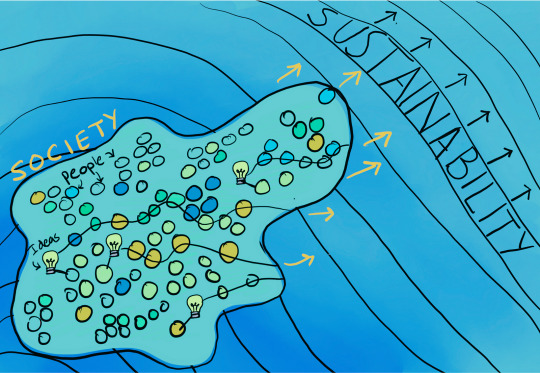
Nearly every social movement that succeeded followed this pattern of slow, then all at once. To get to that point, a certain percentage of people need to participate (estimated variously as 3.5%, to 25%), but importantly, it’s not 100%.
So don’t think of the climate movement as something you’re guilted into. You can choose to be one of the 25% who become early adopters of change.
And you don’t have to worry about the people you can’t convince. They will change when the system changes because that comes first.
Changing the system requires creativity. The first act of creativity is to imagine the possible paths to transformation.
The second act of creativity is to imagine where you can fit into that picture. Old ideas need to be replaced by new ones — about everything from technology to our day-to-day lives. The new ideas spread through you.
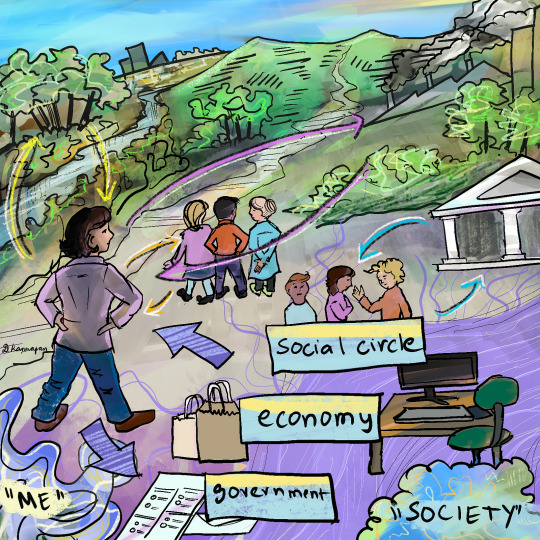
To make that happen, ask yourself these three questions.
One. What is a movement you want to throw your weight behind? Pick a trend or organization that’s already building, and that you can help accelerate. You can be another piece of its critical mass.
Two. What’s a practical obstacle that’s been keeping you from participating? Anything from not knowing what a word means, to having trouble deciding where to volunteer.
If you have this obstacle, others do too. So brainstorming a solution will help more than just you. That obstacle doesn’t stand a chance against your formidable skills at creative problem solving!
Question Three. What social circles that you’re already a part of, can you share your solutions and experiences with? Sharing in the circles where you can be heard is how your solutions amplify and ripple outward.
We’re facing unprecedented challenges, so our imaginations need to be nimble — zipping like a hummingbird — from the big picture, to our immediate surroundings. From where we’re starting from — to where we want to get to.
We can’t be nimble like this if we’re stuck in guilt and perfectionism, and gazing endlessly within our own homes and wallets at all the things we’re doing wrong.
No movement in history has been made up of perfect people, so stop worrying about the ways you’re not perfect. Perfect people are not required.
Instead, think of all the ways your creativity could accelerate us in the right direction.
If you haven’t already, check out the recording of my TEDx talk! And you can hit ‘like’ on the video if you want to help get the YouTube algorithm to distribute it.
#climate change#climate art#climate activism#environmental activism#environmentalism#environment art#solarpunk#hopepunk#hopeposting#activism#pep talk#tedx talks#climate action#climate and environment#social change#environmental justice#collective consciousness#long post#take action#Youtube
87 notes
·
View notes
Note
Is it true some parts will be under water in 2025? I'm kinda of worried cause someone told me about it bc it was on the news
Eh, not really. Like, technically, but that's a very dramatic way to put it.
What that person told you about was probably this prediction, which says that some roads on some of the Florida Keys might be underwater by 2025.
Does that suck? Yes. But it's also pretty limited in scope.
(And by the way, that's probably not "underwater all the time." There will probably be a number of years of "the roads will be underwater at high tide specifically." I can't currently find a source on this, but that's how tides work, and the Florida Keys article does specifically mention them as a main problem.)
The areas in danger first are pretty universally small, very low islands. Actually, a dozen or so small islands have already gone underwater in the Pacific Ocean, but very importantly, none of those islands were inhabited.
They were mostly small reef islands (that is, the entire island is exposed coral reef detritus) and other uninhabited shoals. Mostly, they were so small scientists had to check old satellite images to even figure out that they disappeared. Literally, we're talking about chunks of land that are just 100 square meters/300 square feet. Again, not great, but still very limited in scope.
As this Live Science article thankfully explains, it's pretty unlikely that any countries at all will disappear before 2100.
Also, just because land is below sea level doesn't mean it will be underwater, and there are very real steps we can take to defend a lot of endangered cities/islands.
For example:
Much of the Netherlands is already below sea level, but the country isn't disappearing, because the Dutch have put a lot of work into building and maintaining coastal defenses.
Multiple surveys (including the one that found the missing islands in Micronesia) also found that not all low-lying islands are vulnerable to erosion and flooding. This is because many islands are protected by mangrove forests, lagoons, or both
Mangrove reforestation in particular is genuinely a super effective anti-flooding strategy that is being deployed pretty widely, and is expected to increase a lot in the coming years. Mangroves are effective at not only preventing short-term flooding, but also mitigating sea-level increases (in part by preventing erosion)
Some islands, esp Pacific Islands, have actually grown during the past couple decades, not shrunk. It really depends on what the island is made up of. Not all land is automatically doomed
You can read more about how sinking countries are fighting back here, and the lessons we can learn from them:
-via Time, June 13, 2019
And finally, and this is good news for reasons I'll explain in a second:
Some of the largest and wealthiest cities in the world are at the top of the danger list. (Note: the predictions at that link are based on some fairly severe warming predictions. They do NOT necessarily reflect what's going to happen or when.)
The cities that are going to be in danger the soonest (still away btw) include New York, London, San Francisco, Tokyo, and Dubai. Lots of very rich people in those cities! Who would really like to not have to move (any of their ten different homes lol)
So, flooding aside, we're going to (by necessity) get a lot better at figuring out the quickest, cheapest, most scalable, and most effective types of coastal defenses real fast.
Are rich countries going to be way more able to get strong coastal defense systems up quickly? Yes. Does that suck? Sure fucking does!! But these solutions don't all require a lot of money or tech to implement, even at a large scale, especially when it's local communities driving the effort.
And, importantly, when rich countries pour a ton of money into figuring this out, that will hugely expand our understanding of what techniques work best, why, and how best to deploy them in different situations. Unlike physical structures, that's valuable knowledge that can be shared very, very widely.
And any technology that comes out of this is going to work like solar panels and other green energy: as more people use it, it will get cheaper and cheaper. Probably really quickly.
So, all told, no one's going to be swallowed up in the next few years. We have time to work on this and a lot of people are already doing so.
Mostly, experts predict that the first wave of large-scale issues will be happening around 2050.
Three decades doesn't sound like enough time, in the face of something like this. But you know what? Responses to climate change are speeding up exponentially, and different types of responses are multiplying and magnifying each other.
We went from inventing flight to landing on the moon in just 66 years.
I wouldn't count us out of the climate change fight yet.
(...I wouldn't count on retiring to Florida either, though)
#Anonymous#sea level rise#ocean#micronesia#pacific islander#mangrove#flood#flood mitigation#ask#me#hope#it does suck but I also really do think there is hope#this post was supposed to be like 2-3 paragraphs how did it turn into an entire essay#I have too many words disease#too much nuance#hope yall appreciate the extra context lol
293 notes
·
View notes
Text
I saw herds of 30+ pronghorns just about every day in the summer of 2021 when I lived in SW Wyoming just by looking out my window. This year, I moved my desk to the window so I could watch them cantering across the grass all day. But, after an intense winter that killed thousands of animals--in one area, 100% of collared fawns died--most days I just see an empty field.
There is some science that suggests extreme weather events are linked to climate change, but it's impossible to know exactly what impact it has on any one phenomenon. I wrote about it here in my latest article for Outrider.

#dead animals#Wyoming#pronghorns#climate change#nature#animals#conservation#Science Journalism#SciComm#deerr#antelope#elk
78 notes
·
View notes
Text
Rio Grande do Sul Floods: How Can Brazil's Politicians Not See Climate?
The deadly floods in southern Brazil are unprecedented but not unexpected. Ahead of the October local elections, Brazilians must remember that politicians have ignored scientists' predictions and weakened legislation that could have helped deal with climate change.
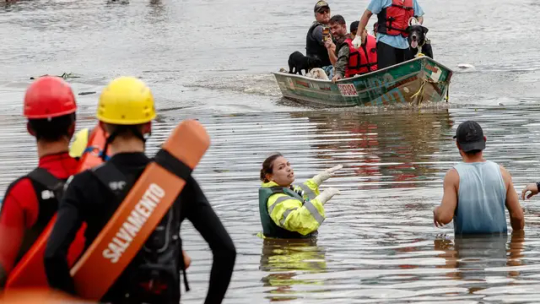
The tragedy that has stuck Rio Grande do Sul, Brazil’s southernmost state, is unprecedented. The amount of rain that has fallen in recent days and is still falling there is extreme and so are the consequences. The death toll has reached 100, and more than a hundred people are still missing. More than 1 million people have been affected.
These impressive figures and the images that look more like disasters caused by hurricanes or tsunamis can generate a false idea of rarity, of bad luck. “It rained like never before, we couldn't have prepared for it" is the phrase most often used to justify calamities like this.
But it is no accident. It was already known, already expected. And, I'm sorry to say, it's going to happen again. And again. And not just with the gauchos in Rio Grande do Sul.
Don't take me for an alarmist or a pessimist. Science has been warning for a long time that the increased occurrence of extreme events is one of the main consequences of climate change. The surreal amount of carbon dioxide that accumulates in the atmosphere — due to human activities — and warms the planet, alters the entire functioning of the climate system. A warmer Earth means more energy in the equation. Heat is synonymous with tragedy.
Due to its geographical location, Rio Grande do Sul is particularly sensitive to the natural phenomena El Niño and La Niña. That's why it's relatively common for droughts and heavy rains to alternate there. But global warming is making this worse. So is deforestation. And although much of this new reality translates into situations that seem to take us by surprise, scientists had already estimated that this would be the case. The consecutive tragedies that have been accumulating since last year were not for lack of warning.
The independent online newspaper Intercept Brasil recalled on May 6 a study commissioned in 2014 by the government of then president Dilma Rousseff that warned of the risk of flooding in Rio Grande do Sul. The "Brazil 2040" report mentioned the dangers of agribusiness, especially in the state, and also of hydroelectric dams, which clashed with the government's electricity expansion plans. The report ended up being shelved in 2015 without any action being taken.
We didn’t have to wait until 2040 for predicted dangers to become reality. And it wasn't just this study that warned about the risks. Local researchers, such as Francisco Aquino, a climatologist at the Federal University of Rio Grande do Sul (UFRGS), have shown that extreme events are already intensifying, without anything having been done to prevent deaths and losses.
Last year, Rio Grande do Sul was the state with the highest number of rain-related emergency and disaster decrees in Brazil.
Continue reading.
#brazil#brazilian politics#politics#environmental justice#climate change#rio grande do sul floods 2024#mod nise da silveira#image description in alt
22 notes
·
View notes
Text
On Tuesday, Santa Ana winds swept seaward through Southern California, scattering embers and then fanning flames of a growing wildfire. By nighttime, residents received urgent text alerts warning of potential 100 mph gusts—a terrifying escalation that transformed a precarious situation into a full-blown crisis. As the winds howled, more embers took flight, sparking new fires in dry, brittle brushlands that hadn’t seen significant rain in over eight months.
Los Angeles County, primed by drought-like conditions, was a tinderbox waiting for a spark. Firefighters faced an uphill battle against winds so severe that airplanes used to drop water and flame retardants were grounded. Officials warned in a Wednesday morning press release that “all residents of Los Angeles county are in danger.” Evacuation orders have since displaced tens of thousands of residents, with thousands more awaiting updates. By Wednesday evening, three major fires had consumed over 13,000 acres with containment efforts lagging: The Palisades Fire in Pacific Palisades and Malibu, Hurst Fire in Sylmar, and Eaton Fire near Pasadena have showed no signs of slowing down, are at the time of writing 0 percent contained, and have already become the most destructive in California history.
The fires turned catastrophic so quickly because of unusually dry and windy conditions: “Any little spark, whether from a lightning strike or a person or a campfire is going to quickly, quickly escalate,” says Jennifer Marlon, research scientist and lecturer at the Yale School of the Environment and the Yale Program on Climate Change Communication. “Once a fire starts in these conditions, it’s very, very hard to get under control,” adds Kaitlyn Trudeau, senior research associate of climate science at the nonprofit news organization Climate Central.
Santa Ana winds events aren’t uncommon. “We see it every single year at this time,” says Jason Moreland, senior meteorologist at emergency communications platform AlertMedia. These downhill winds, which originate inland, are caused by a dry high-pressure system coming from the northwest, and a low, humid pressure system from the south. “It’s like if you have a hose and you fold it in half to cut off the water. If you prick a hole in the side, you have a lot of pressure to get out,” explains Trudeau. “That’s basically what’s happening with the air.”
However, these winds are a lot stronger than usual because of a dip in the jet stream near the Baja Peninsula in northwestern Mexico, Moreland explains. Winds that are usually relegated to higher elevations are reaching lower terrain areas. “Every so many decades, we do get wind events of this magnitude,” he says.
While this wind event seems extreme, Noah Diffenbaugh, professor and senior fellow at Stanford’s Woods Institute for the Environment, explained that it might just be due to natural weather variability—and more research is needed to know if it is caused by climate change.
However, while the winds aren’t unseasonal, climate change is increasing the risk of late- or early-season wildfires in California. “This is not only a particularly strong wind event, but is also a particularly dry season here in the beginning of January,” says Diffenbaugh. Southern California’s wet season, which runs from October through April, has seen record low precipitation, following one of the driest falls on record. As precipitation is more variable due to climate change, the overlap between the windy season and the dry season is increasing. “We’re seeing a significant amount of more, hot, dry, windy days, especially in Southern California,” says Trudeau.
Adding to the problem, the two previous years saw above-normal precipitation, leading to growth of vegetation and foliage in the mountain regions. “That was priming the land, so to speak,” says Moreland. “All that vegetation has now cured and is more flammable, and we’re seeing easier ignitions, more rapid fire spread.” The proximity to people and structures compounds the risks: “The houses intermixed with the vegetation is what’s so problematic because, in this case, the houses are providing a lot of the fuel,” says Marlon.
Plus, all of these events are occurring against a backdrop of warmer annual temperatures due to climate change. “Just boosting that background temperature a little bit can allow fires to rapidly escalate,” says Marlon.
Diffenburgh likens it to a baseball game: Climate change doesn’t have to hit the home run to affect how many runs are scored. “If it puts runners on base, then the impact of the home run is increased,” he explains. In this case, the bases were loaded with dry conditions, warm temperatures, and fuel. The winds were just up to bat.
Without rain in sight, many regions are still vulnerable. “Southern California relies on the winter months for their wet season,” says Moreland. “If you don’t get beneficial precipitation during this time of the year, it doesn’t bode well for really the rest of the spring and summer months going into 2025.” Fires are also happening in unexpected places at unusual times: “There are many aspects to the fires that are changing: Their place, their location, their timing, their severity, their size, the whole nature of fire in a warmer climate is different,” says Marlon. “All of this is happening in the context of an incoming president who has called climate change a hoax,” says Marlon. “To me, it’s really alarming that we’re going to have this vacuum in leadership right when we need to be protecting people and preparing the most.”
As fires are increasingly common, severe, and unpredictable, better preparation and climate adaptation is crucial to mitigate future disasters. Local organizations and governments are working to protect homes and communities, and advances in fire-resistant building materials, more aggressive fuel management programs, and improved early warning systems can—and already are—making a difference. “We should be keeping this in mind as development expands and continues to encroach into these places that regularly naturally burn,” says Marlon.
5 notes
·
View notes